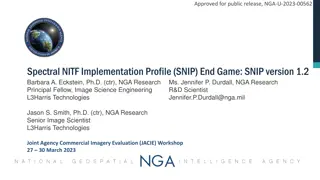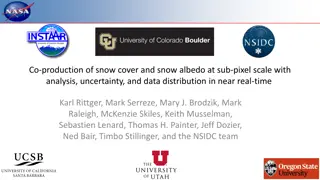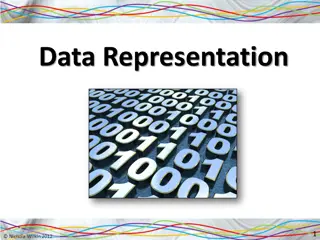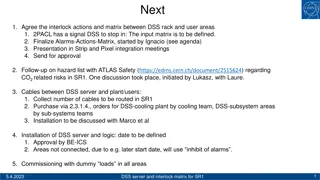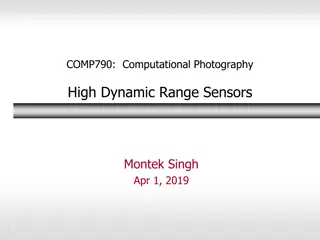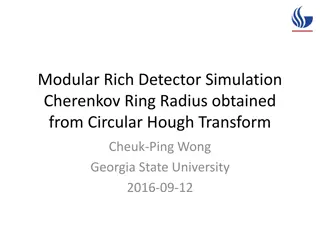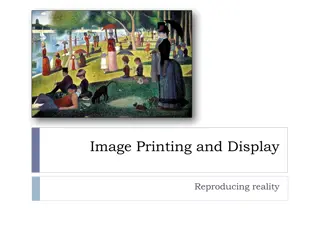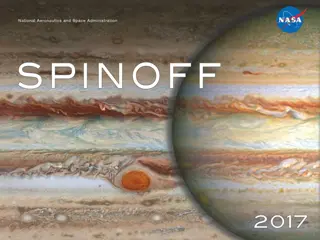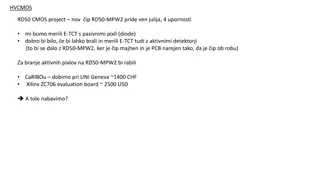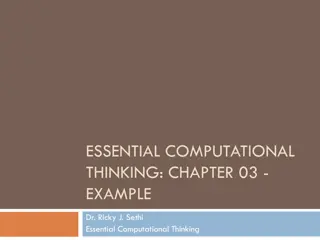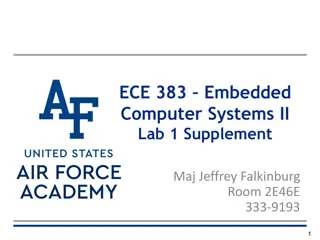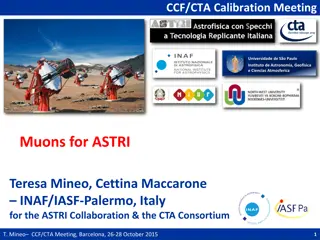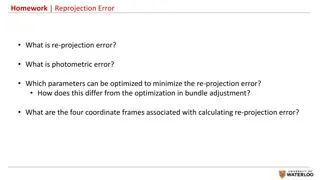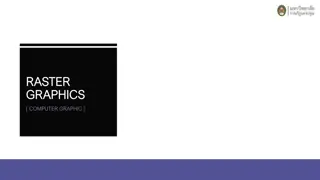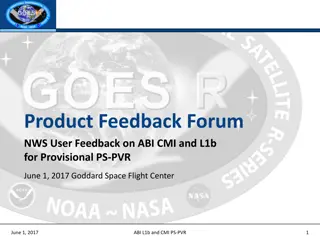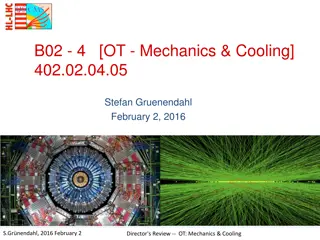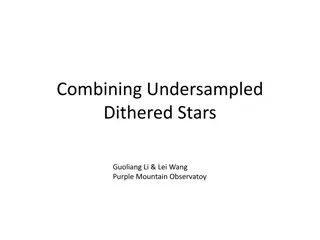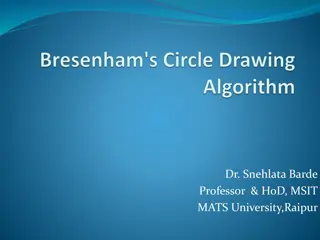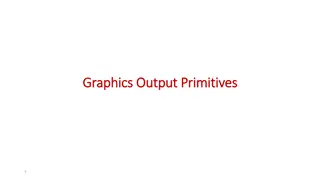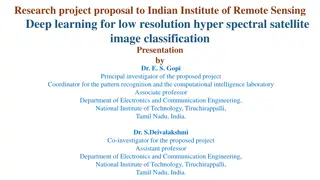Enhanced Spectral NITF Implementation Profile (SNIP) Version 1.2 Overview
This document outlines the Spectral NITF Implementation Profile (SNIP) version 1.2, its development, applications, and new elements. SNIP is a mandated standard for EO still imagery on DoD and IC systems, aiming to reduce integration costs and meet advanced exploitation needs for future HSI systems.
2 views • 14 slides
Understanding Remote Sensing Sensor Resolutions & Colour Composite
Explore the art and science of remote sensing, detailing sensor types, resolution categories, and color composite techniques. Learn about the stages involved in remote sensing, sensor variations, and band designations for satellites like Landsat 8. Discover the significance of pixel, high-resolution
3 views • 13 slides
Innovations in Pixel Detector Technology for Photon Science
Technologies and advancements in pixel detector development for photon science applications are showcased in this content. Topics discussed include balancing gain and dynamic range in hybrid pixel detectors, performance assessments of integrating pixel detectors, and strategies for photon detection
4 views • 21 slides
Advancements in Near Real-Time Snow Cover and Albedo Monitoring
Explore the innovative co-production approach for monitoring snow cover and albedo at a sub-pixel scale in near real-time, funded by NASA Terra Aqua Suomi. The project aims to provide valuable insights on snow surface properties, including snow cover fraction, albedo, and radiative forcing, through
6 views • 8 slides
Immersive Decentraland Experience in Pixel Paradise
Decentraland Script Development, Decentraland Virtual World Clone, Blockchain-Based Virtual Reality
3 views • 5 slides
Are you ready to take your business to the next level? Check out Maven Group
Elevate your brand with a stunning website that reflects your vision. Our team at Maven Group Global is dedicated in bringing your ideas to life, pixel by pixel. Let's build an online home for your brand together.
0 views • 2 slides
Understanding Bitmap Images and Image Quality Enhancement
Explanation of how computers store bitmap images using pixels and binary representation. Practice exercises to draw pixel images on grids, demonstrating the impact on image quality when using different grid sizes. Learn about pixelation and improving image quality by using more detailed grids.
1 views • 13 slides
Interlock Actions and Matrix for DSS Server in SR1 Environment
Proposal and implementation plan for interlock actions and matrix coordination between DSS server rack and user areas in SR1. Includes agreements, alarms-actions matrix finalization, cable routing, server installation, and commissioning with dummy loads. Discusses CO2 plant signals, temperature moni
3 views • 7 slides
Analysis of Epi/Stroma Segmentation with High Pixel Agreement Rates
In this analysis of Epi/Stroma segmentation, multiple images were evaluated, showing overall pixel agreement rates ranging from 0.9211 to 0.9625. True Positive Rates were high, while False Negative Rates varied. The study provides insights into the effectiveness of the segmentation process.
0 views • 10 slides
Understanding Pixel Relationships in Image Processing
Exploring the fundamental concepts of pixel relationships in image processing, including 4-neighbors, 8-neighbors, adjacency criteria, and their significance in digital image analysis. The content covers the basics of pixel connectivity and neighbor sets, offering insights into how pixels interact a
0 views • 67 slides
Understanding High Dynamic Range Sensors in Computational Photography
Dive into the world of High Dynamic Range (HDR) sensors in computational photography with topics covering sensor architectures, CMOS sensing techniques, dynamic range evaluation, and basic concepts related to image sensors and pixel integrators. Explore the importance of dynamic range in capturing a
6 views • 33 slides
Pixel Array Status and Drawing Rules for High-Resistivity Epi Design
This collection of images and descriptions provides an overview of the pixel array status as of April 26, 2019, along with drawing rules for high-resistivity epi design. The pixel array features various components such as Pixel_S1, Pixel_S3, and the overall array structure. Drawing rules highlight t
4 views • 9 slides
Emittance Measurement Techniques and Analysis
Various emittance measurement techniques like Solenoid and Viewscreen, Single Slit and Viewscreen are discussed in this document along with details on the measurement process, equipment setup, and data analysis methods. Emittance calculations, beamlet intensity profiles, and space-charge dominated b
0 views • 11 slides
Advancements in Pixel Readout R&D for Large Liquid Argon Time-Projection Chambers
Explore the latest developments in pixel readout research and development for large liquid argon time-projection chambers (LArTPCs) presented by Dan Dwyer at the CYGNUS Collaboration Meeting. Learn about signal characteristics, wire signal ambiguity, challenges in true 3D readout, and the innovative
0 views • 13 slides
Cherenkov Ring Radius Determination from Modular Rich Detector Simulation
Explore the process of obtaining the Cherenkov ring radius using Circular Hough Transform in a modular rich detector simulation. The study, conducted by Cheuk-Ping Wong from Georgia State University, delves into Monte Carlo results, ring finder algorithms, event displays, and radius distributions in
0 views • 20 slides
Understanding Image Display and Halftoning Techniques
Images are reproduced for display on various devices like televisions, computer monitors, and newspapers with specific characteristics such as pixel shape, spatial resolution, and color depth. Issues with display devices, such as pixel resolution and color depth, affect fidelity. Halftoning methods,
3 views • 44 slides
WP7-DETEC Kick-Off Meeting: Advancing Detector Technologies for Particle Physics
WP7-DETEC is a collaborative initiative focusing on the development of state-of-the-art detector technologies in the fields of nuclear physics and high-energy physics. The kick-off meeting aims to foster cooperation, exchange ideas, and educate young scientists in the field. Activities include sessi
0 views • 7 slides
The Sound Pixel Project: Innovative Audio Design and Implementation
Explore the Sound Pixel Project, a cutting-edge initiative showcasing a transportable and easily constructed frame design concept utilizing lightweight aluminum alloy composite framing. With a focus on independent sound emitters and six sets of stereo speakers, the project also delves into music mix
0 views • 6 slides
Innovative NASA Medical Technologies Transforming Healthcare
NASA's groundbreaking technologies are revolutionizing healthcare, including active pixel sensors for dental imaging, mini-heat pipes for brain surgery, and fluorescent diagnostic test readers for fast results. These advancements improve accuracy, efficiency, and patient comfort, showcasing the impa
1 views • 60 slides
Advanced Technologies for Particle Detection and Monitoring
Cutting-edge technology such as HVCMOS RD50-CMOS project along with CaRIBOu and Xilinx ZC706 evaluation board are being employed for precise measurements in E-TCT with passive and active pixel detectors. The development of Radiation Monitor Sensor Boards for ITk, involving sensors like RadFETs and d
0 views • 6 slides
Cutting-Edge Astrophysics Research at NextBASS: Advancing Sensitivity and Resolution
Cutting-edge research at NextBASS, a collaboration between University of Oxford and Hochschule Munich, aims to cover a frequency gap between 7-30 GHz with advanced technology. The project involves achieving equivalent sensitivity to future cosmic microwave background missions, utilizing multiple fee
0 views • 25 slides
Computational Thinking Example for Image Storage Calculation
Explore a computational thinking example involving calculating how many images of different formats can be stored on a flash drive based on user input drive size in gigabytes. Understand image compression ratios and pixel resolutions to develop a Python program that outputs the number of images that
0 views • 17 slides
Embedded Computer Systems Lab 1: VGA Module Overview
This document provides an overview of Lab 1 for Embedded Computer Systems II, focusing on the VGA module and its functionalities. It includes details about the VGA module entity, its ports, clock signals, trigger voltage and time representation, channel signals, color intensities, row and column val
0 views • 18 slides
Understanding K-means Clustering for Image Segmentation
Dive into the world of K-means clustering for pixel-wise image segmentation in the RGB color space. Learn the steps involved, from making copies of the original image to initializing cluster centers and finding the closest cluster for each pixel based on color distances. Explore different seeding me
0 views • 21 slides
Analysis of Muons for ASTRI at CCF/CTA Calibration Meeting
The analysis carried out at the CCF/CTA Calibration Meeting focused on muon detection for ASTRI using simulations and analysis software. Steps included pixel cuts, center and radius determination, image cleaning, radial and intensity profile computation, and reconstruction error evaluation. Results
0 views • 8 slides
Understanding SSUSI Data Analysis: Variable Selection and Geolocation Techniques
Delve into the world of SSUSI data analysis with a focus on selecting the right variables for analysis and utilizing geolocation techniques. Explore the utilization of specific data fields like YEAR, DOY, and TIME, along with understanding geolocation coordinates and pixel geolocations based on alti
0 views • 13 slides
Understanding Spatial Error in Photogrammetry
Reprojection error in photogrammetry refers to the discrepancy between a known point in a scene and its projected position on an image. Photometric error, on the other hand, involves errors related to pixel intensity values. To minimize reprojection error, parameters such as camera intrinsics, extri
0 views • 5 slides
Overview of Fair Funding Review Consultation Paper
CCN commissioned Pixel Financial Management to model potential implications of the Fair Funding Review (FFR) to support their responses to current and future consultations. The FFR consultation paper by MHCLG deals with needs in the formula, with future papers focusing on resources and damping. The
0 views • 26 slides
Understanding Raster Graphics in Computer Graphic Design
Raster graphics, also known as bitmap images, consist of a grid of pixels representing colors, viewable on screens or printed media. They are stored in various file formats and are characterized by width, height, and color depth. Contrastingly, vector graphics are line-based and offer scalability wi
0 views • 7 slides
Summary of ITk Pixel Status Reports and Organization Updates
The content provides updates from ITk Pixel Status Reports on project transitions, decision-making processes, organizational structure, and key focus areas. It also outlines responsibilities, strategic planning, and critical items to address within the project timeline. The Planning section outlines
0 views • 24 slides
Progress Update on Phase-2 CMS Pixel R&D Activities in Italy by Marco Meschini
Marco Meschini presents updates on Phase-2 CMS Pixel R&D activities in Italy. Updates include sensor production, wafer batches funded, thinning processes, bump bonding technologies, and irradiation campaigns. The meeting discusses wafer specifications, Epi wafer procurement challenges, and productio
0 views • 28 slides
Exploring Forest Change Impact on Carbon Storage
Explore the impact of human activities on forest change and carbon storage through map analysis and pixel calculations. Students investigate the correlation between forest coverage and carbon stored in different areas, fostering understanding of ecosystem disruptions and climate change factors.
0 views • 4 slides
Product Feedback Forum at NWS: Provisional PS-PVR User Feedback on ABI, CMI, and L1b
A comprehensive feedback system managed by PRO at NWS, focusing on user input for GOES-R products such as ABI, CMI, and L1b. The forum gathers feedback through surveys and weekly calls, addressing product quality issues and ensuring effective communication with field sites. Noteworthy discussions in
0 views • 18 slides
Director's Review - Mechanics & Cooling Overview
The US will design and build the central portion of the Phase 2 Tracker Barrel Pixel Strip Detector (TBPS), focusing on mechanics and cooling. The project involves three layers of PS modules with specific lengths, utilizing carbon fiber/carbon foam sandwich planks with embedded CO2 cooling. Collabor
0 views • 19 slides
Advanced Image Processing Techniques for High-Quality Reconstruction
Cutting-edge methods in astrophotography, such as deconvolution and pixel convolution effects, are explored in this detailed presentation. These techniques offer superior image restoration compared to traditional algorithms, emphasizing the importance of addressing pixelation effects to achieve high
0 views • 9 slides
Bresenham's Circle Drawing Algorithm Explained
Bresenham's Circle drawing algorithm is a fast and efficient method for drawing circles using integer arithmetic. It divides the circle into octants and selects the nearest pixel positions to create smooth arcs. This algorithm is widely used for graphics applications due to its speed and accuracy.
0 views • 15 slides
Understanding Graphics Output Primitives and Coordinate Reference Frames
Graphics output primitives and coordinate reference frames play a crucial role in describing scenes and drawing basic geometric structures in 2D space. These concepts involve defining points, drawing lines, and understanding pixel coordinates within a coordinate system. Absolute and relative coordin
0 views • 35 slides
Update on Pixel and IBL Detectors for Run 2 at CERN
Publications and plot approvals for the IBL paper are in review stage, with updates requested for the author list. Various proceedings and notes are being prepared, including a 4-layer pixel paper proposal focusing on LS1 work and early beam results. Plans for mid-2015 include beam splashes validati
0 views • 12 slides
Deep Learning for Low-Resolution Hyperspectral Satellite Image Classification
Dr. E. S. Gopi and Dr. S. Deivalakshmi propose a project at the Indian Institute of Remote Sensing to use Generative Adversarial Networks (GAN) for converting low-resolution hyperspectral images into high-resolution ones and developing a classifier for pixel-wise classification. The aim is to achiev
0 views • 25 slides
Comparative Study of Different Strip Detectors for Dark Current Results
Explore various strip detectors including old baseline, extra-distance, and guard ring surrounding detectors through images showing pixel current behavior when biased. The study highlights the impact of guard ring presence on lowering pixel current in these detectors.
0 views • 6 slides
